The stock market industry has witnessed huge technological adoption recently with the surge in stock market APIs.
This change in the face of the stock market industry is growing so swiftly that it has created a paradigm shift, influencing modern financial institutions. Innovative technologies like cloud-based application programming interface (API) are inflowing the landscape for all good reasons.
But why is everyone talking suddenly about Stock APIs?
Well, to understand this, let’s zoom in on the best stock market API followed by the relevance of stock APIs for financial market data consumers, their relevance, and the types of stock market APIs available.
After some research and analysis, I’ve finally whittled down my list of the best stock market APIs to these listed below:
- 1. Alpha Vantage
- 2. Marketstack
- 3. Financial Modeling Prep
- 4. Finage
- 5. Barchart
- 6. Finnhub
- 7. EOD Historical Data
- 8. Tiingo
- 9. Intrinio
- 10. Nasdaq
- 11. Polygon
- 12. Alpaca
- Show less
You can trust Geekflare
At Geekflare, trust and transparency are paramount. Our team of experts, with over 185 years of combined experience in business and technology, tests and reviews software, ensuring our ratings and awards are unbiased and reliable. Learn how we test.
1. Alpha Vantage
Alpha Vantage is a leading provider of stock data APIs as well as fundamental data, financial news & sentiments, foreign exchange rates (forex), commodities, economic indicators, and technical indicators. It is backed by Y Combinator, a pioneering Silicon Valley based venture capital firm. It also has a large open-source ecosystem, with over 700 GitHub libraries built on top of its APIs.

Alpha Vantage ensures smooth API integration without friction. It supports Python, PHP, Java, Javascript, and more. You also get official add-ons you can use for Google Sheets and Excel in case you prefer to access data through spreadsheets.
You also have the option to get data in JSON formats. Get started and start building your financial products using the high-quality data Alpha Vantage offers you. You can browse the API documentation to understand their API library and keep exploring.
2. Marketstack
Whether you want historical market data, intraday, or real-time data, Marketstack is there for you!
Get an easy-to-use REST API to obtain stock market data. To facilitate simplicity, it allows you to request data through HTTP GET and get response data in JSON format. Here, you have the flexibility to use a free or paid version according to your necessity.
With Marketstack, you can get 30+ years of precise historical data to drive meaningful insights. Integrate this API easily and utilize over 125,000 stock tickers across the globe from 72 stock exchanges, including NYSE, Nasdaq, ENX, TYO, ASX, and more.
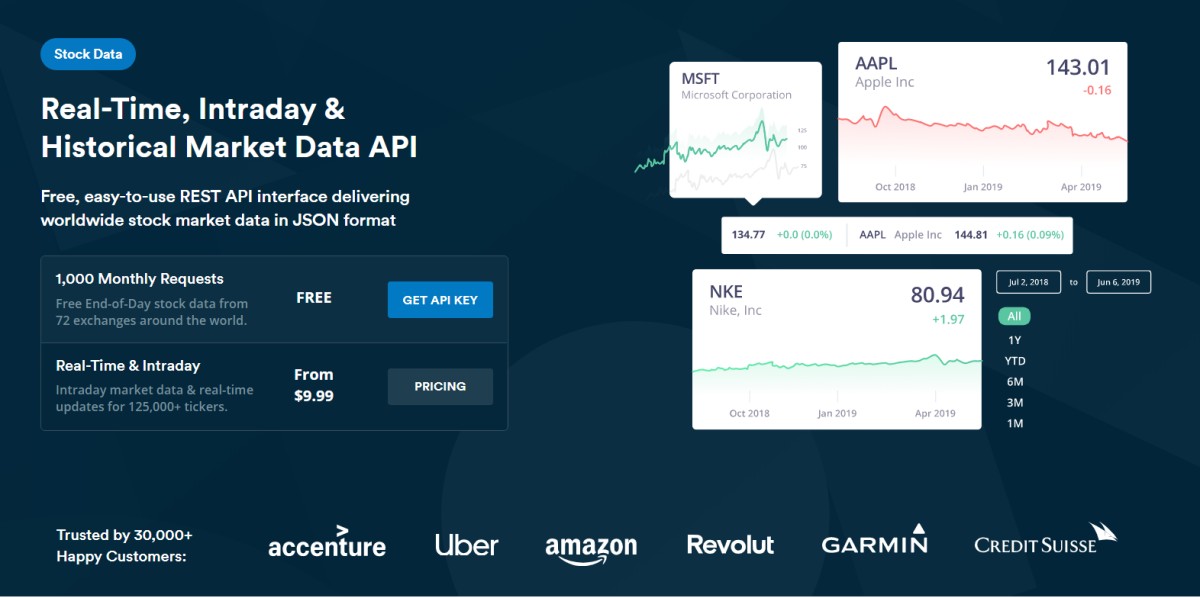
The REST API of Marketstack is simple yet scalable and robust, capable of delivering up to 100% uptime. Just get started within 5 minutes and continue exploring new horizons. If you want to use its free plan, you don’t need a credit card, payment, or contract. You can get instant access to the API and enjoy up to 1000 requests per month with end-of-day stock data, even in the free plan.
Marketstack leverages state-of-the-art technologies with great scalability of cloud infrastructure to build the stock API. As a result, it can effortlessly handle request volumes of different sorts – from hundreds to millions on a single day.
When it comes to security, Marketstack offers bank-level security by encrypting each byte with industry-level 256-bit HTTPS encryption. With extensive documentation like code examples and demo requests available on API, you can start using it without any hassle.
3. Financial Modeling Prep
Building financial applications and models has never been easier with Financial Modeling Prep (FMP) fast, accurate, and easy-to-use financial market data. With over 30+ years of historical price and fundamentals data across 90+ exchanges and over 70,000 symbols, FMP provides financial data for every need.

With over 150+ different endpoints, covering everything from Fundamentals, Real-time Quote, Historical Chart, Intraday Prices, Price Targets, Earnings Call Transcripts, Analyst Ratings, ESG Ratings, Interstitial Holdings, Stock News, and more, FMP offers a wealth of financial market data.
Each Financial Modeling Prep endpoint provides data via JSON or CSV format, with websocket delivery for real-time quote data. FMP supports multiple languages like Java, C, C++, Javascript, Python, etc., to reduce development time.
Start using the API with the free plan, allowing you to query and test data with 250 requests per day. With FMP’s versatile pricing plans, you can scale your application and business cost-effectively. For custom and advanced solutions, the FMP Enterprise Solutions team can build tailored offerings to meet your unique requirements.
4. Finage
In today’s fast-paced financial world, access to real-time stock market data is crucial for traders and investors aiming to stay ahead of the curve. Finage steps into the spotlight with its cutting-edge API, designed to revolutionize how we access US and global stock market data.

Tailored for developers, financial analysts, and traders seeking an edge, Finage offers comprehensive solutions via Restful API and WebSocket, catering to a broad spectrum of needs from real-time to historical data.
Unlike traditional services, Finage doesn’t rely on direct exchange data for stocks, giving users a powerful advantage. By sourcing information from over-the-counter, peer-to-peer, and market makers, Finage ensures a unique blend of data accessibility and integrity.
This methodology allows for an impressive 99% price accuracy, making it a reliable resource for those who require precise market insights without the direct exchange premium.
Furthermore, Finage distinguishes itself with unparalleled ease of integration and user-friendly access. Its APIs are crafted to ensure seamless incorporation into applications and websites, enabling developers to effortlessly leverage real-time financial information. Combined with competitive pricing and a generous free trial, Finage stands as an attractive choice for both startups and established enterprises looking to innovate or expand their financial services.
Finage’s US and global stock market API is the key to unlocking the potential of real-time financial information. In your quest for superior stock market data, Finage is not just a provider; it’s a partner in your financial journey, ensuring you have the tools needed to navigate the complexities of stock markets with confidence and clarity.
5. Barchart
Build your products with more profound insights into the stock market using the Barchart OnDemand. It provides you with flexible and cloud-based APIs to strengthen your workflows, products, and applications.
With Barchart, you can get power charts representing historical and real-time market data. Integrating data into a website is simple, and you can use the data to shape your present business strategy. In addition, you can create dynamic tools and applications without hassle.
With built-in scalability with the cloud, you can accelerate your workflows. Barchart uses Amazon Web Services (AWS) to maintain data centres in the United States and ensures maximum data redundancy and reliability.

In addition to cloud, Barchart maintains physical data centres as well to meet specific client requirements. Those are Equinox-based centres with low latency and physical backups. Thus, you have the freedom to choose any of the data centre models you want.
Utilizing built-in security systems and server virtualization, Barchart helps scale up its services in no time. It supports both POST, GET, and SOAP requests and can deliver data in several formats, including CSV, JSON, XML, and supports WebSockets as well.
Barchart OnDemand is compatible with multiple operating systems such as Linux, Windows, Android, and iOS. It also works on different programming languages like Java, Python, PHP, ASP.NET, and R.
When it comes to pricing, Barchart charges based on your data usage. It offers versatile plans that you can choose based on the scale of your business and pay for only what you use.
6. Finnhub
Utilize the powerful stock market API of Finnhub Stock API to obtain data for building your financial products. It gives you real-time WebSocket and RESTful APIs for stock data, cryptocurrencies, and fiat currencies.
Finnhub provides financial statements in detail for companies across the globe from the past 30+ years. You can get the complete list of all the shareholders that are categorized based on institutions and individuals.
They also give you earning notifications in real-time, upgrades or downgrades, price targets, and historical surprises that you can use to further shape your financial products. Besides, you also get dividends data of 30 years.
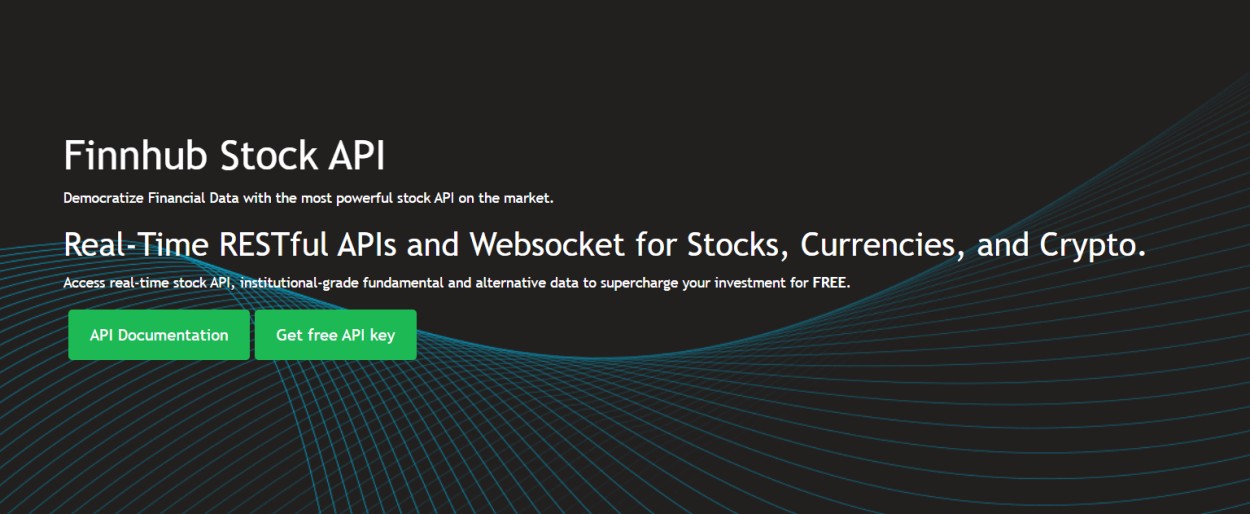
Get historical data of 25 years for the US stock market in real-time, connect with more than 10 Forex brokers, and access over 15 crypto brokers. It also gives a complete pre-computed technical analysis, pattern recognition, support or resistance levels, and aggregate indications. You can access to call transcripts of over 20 years of earnings and download audio.
Do you want to know the history of acquisitions and mergers?
The API makes it possible!
It provides current stock market news to understand all the happenings at present. Study the COVID-19 disruptions on the market through the real-time statistics of the pandemic. Furthermore, Finnhub promises 99.99% uptime, along with an SLA and automatic scalability.
7. EOD Historical Data
Obtain stock market data by utilizing the affordable and flexible services of EOD Historical Data. It offers historical and delayed data, end-of-day, technical, fundamental, dividends, and splits.
It supports 60+ stock exchanges worldwide at the moment. For fundamental data, it supports major stock exchanges, both US-based and non-US, and brings data from 20+ years. They also have ten years or last 20 quarters of data belonging to some minor exchanges.
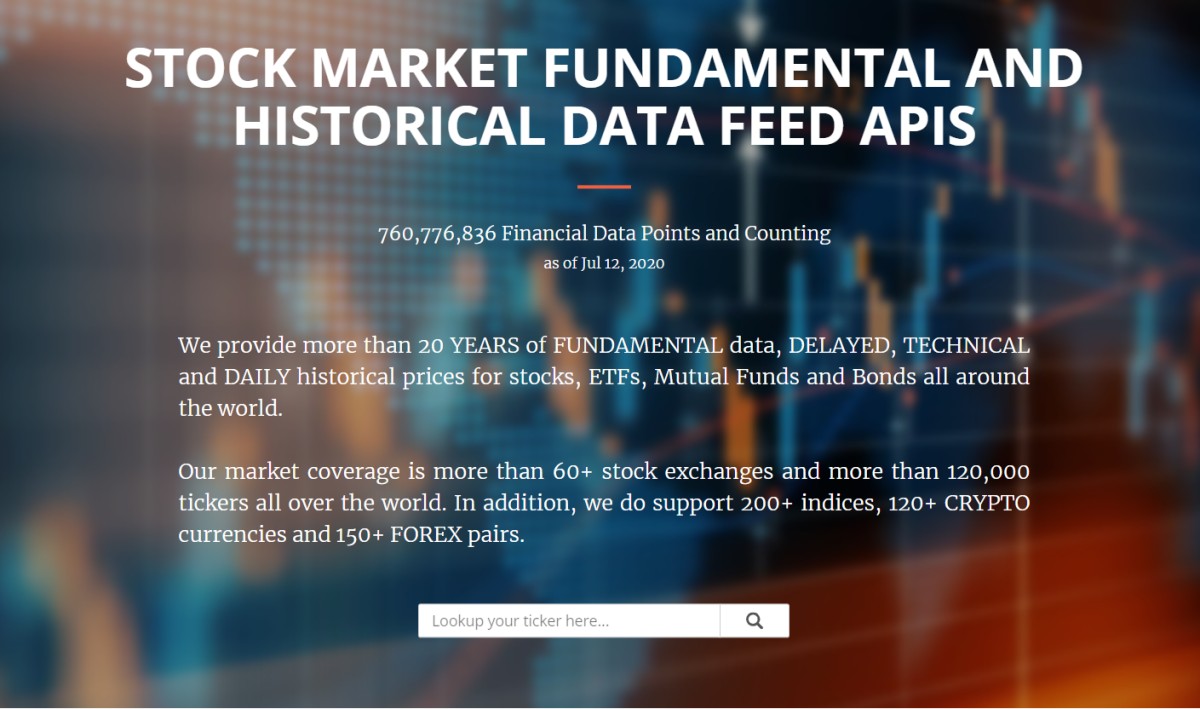
With a rich 30+ years of EOD History covering indices, 45k+ mutual funds, US stocks, and ETFs, you can execute better data analysis. It provides accurate and reliable data from 15+ sources, covering a large number of stock exchanges.
To test the integrity of data, they also use several sources to compare the data and deliver only the best to you. Get superfast support anytime via chat and email in case anything goes wrong. They usually solve 99.99% of issues in 24 hours or less.
EOD Historical Data facilitates flexible prices where you have to pay for the services you use. Its pricing starts from $19.99/month for 100,000 API requests/day, 1000+ Forex pairs, 100+ indexes, and more.
8. Tiingo
Whether you are an individual developer, a technology firm, or have hedge funds, Tiingo can power your financial products.
To deliver precise end-of-day prices, it uses a proprietary framework for error-checking to collect clean data. This framework also helps them with missing events and for creating redundant feeds. Tiingo News feeds contain 16 million useful articles curated based on years of research.
These articles are a treasure with historical market data from 20+ years. The news feed is a source of tagged content containing financial and non-traditional news. Tiingo’s Crypto API includes multiple exchanges with a stream of valuable data, both historical and intraday data.
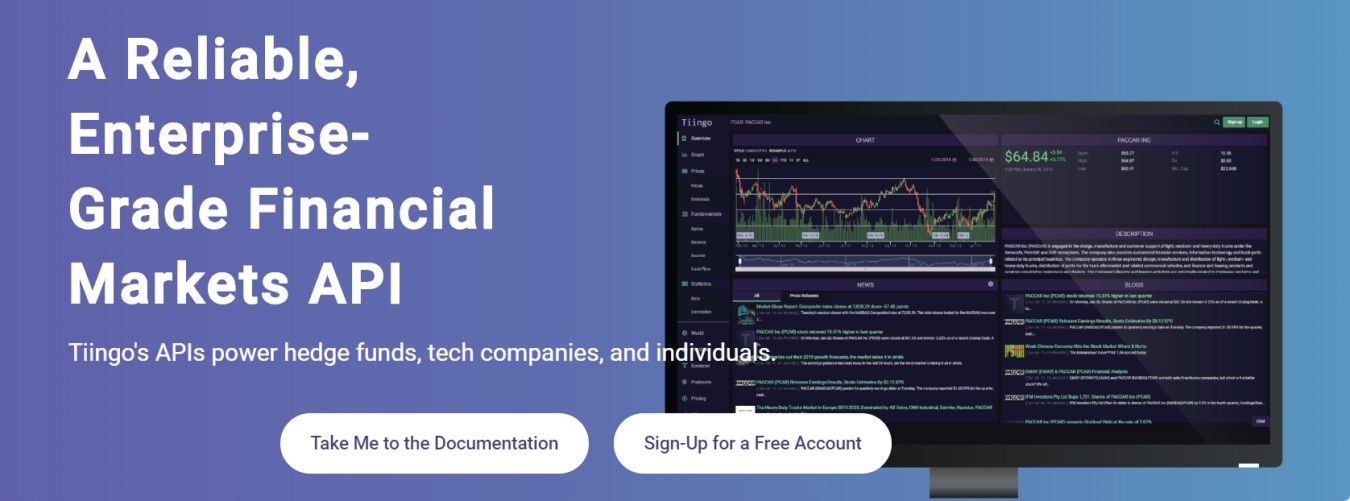
You can segment exchanges and currencies to use data the better way. With Forex and FX feed, you can access tier-1 banks along with institutional-level liquidity. Access their cross-connect to get IEX stock API in real-time, exhibiting high-performance and minimal latency.
Tiingo deploys fast servers and consistent uptime with optimized memory caching. It also continuously performs data audits to provide uninterrupted data delivery.
Access historical and intraday data with top-of-book updates through REST APIs, while for real-time data with top-of-book updates, use WebSockets.
9. Intrinio
Intrinio provides end-of-day, historical, intraday, and real-time data you can utilize in your financial product building. It allows you to download precise historical market data from the past 5-50 years.
If you are looking for market data on a subscription basis for shaping your investment strategies and building applications, Intrinio’s offerings are varied. You can get pricing data associated with different asset classes, financial statement information and analysis, estimates, projections, and ratings.
In addition, you get aggregated, industrial, and economic data. Get data for holdings, metadata, and analytics for ETFs.
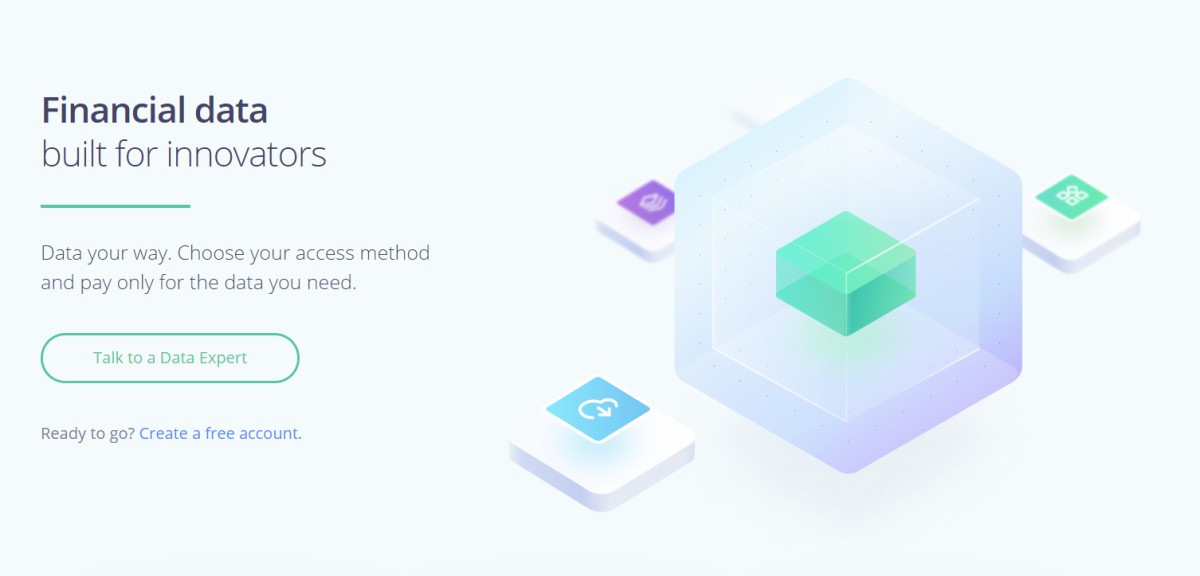
But if you just need to download historical market data for one time only to power your backtesting theories or machine learning algorithms, Intrinio has features for you too.
Besides, you get the financial data of the US Municipality for 2017 that includes entity ID, names, items, and so on. It also offers 18+ years of Forex data, including all the market activities and prices.
10. Nasdaq
Nasdaq is the American Stock Exchange, ranked second-highest by market capitalization of shares traded after the New York Stock Exchange.

Nasdaq API is simple yet powerful and provides access to millions of financial and economic information from over 250 sources onto a simple interface and eliminates the need to manage various sources and constantly changing publication formats.
It offers simple calls to retrieve historical stock prices in CSV, JSON, or XML format. The API can handle complex datasets, such as quarterly percentage changes in stock prices.
On the portal, users can access hundreds of free datasets from various sources. Users can request more datasets, and new data is uploaded on a weekly basis.
Formats, date ranges, row and column restrictions, sorting, and computations are all supported via the API.
11. Polygon
Give more power to your developers through Polygon API to help them with raw and accurate financial data, including cryptocurrencies, Forex, and stock data.
Whether you want historical or real-time data, you can get unlimited access to them. Polygon offers 24k+ symbols and full market coverage, real-time WebSockets including aggregates, trades, quotes, trading halts, and limit up/down.
Get reference data RESTful APIs for markets, locales, market status and holidays, stock splits, dividends, and financials; tickers with its types, news, and details.
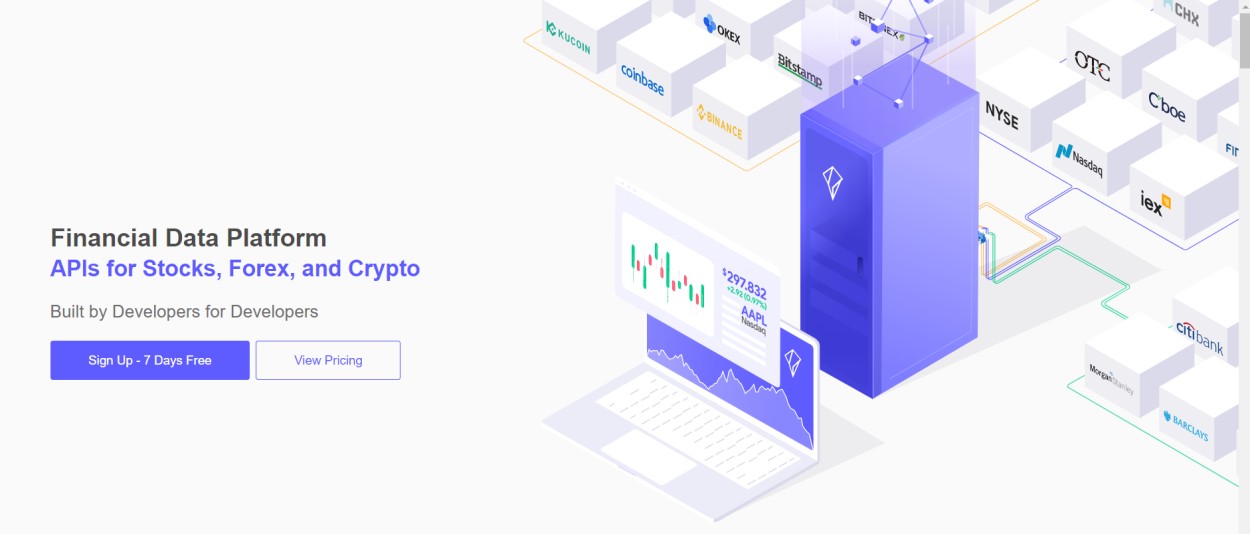
Polygon also provides currency APIs that include data from 1000+ Forex pairs and ten banking organizations.
You can build applications in multiple languages like Java, C, C++, Javascript, Python, etc. It saves your developmental time that you can invest in integration. To simplify things, Polygon offers sample codes in different languages.
Polygon gives you reliable and fast data with ultra-low latency of less than one millisecond. It offers fast Equinix NY data centers with multiple redundancies and the capability of sending 1+ million messages in a second.
For 100% stock market coverage, including 16 US-based stock exchanges and dark pools, it costs $199/month for personal use. Similarly, it costs $49/month for 1000+ Forex pairs plus tick-by-tick updates and $49/month for Level 1& two crypto data access from big banking institutions and exchanges.
12. Alpaca
Leverage the commission-free API of Alpaca to build your financial products. Your developers can easily manage stocks, algorithms, and capital using the single integrated system. Its trade API is a REST interface connecting applications with brokerage service in real-time.
Access account data, orders, assets, positions, and many more. It’s paper trading API also allows you to test your codes, algorithm resets, etc. and offers a Streaming API that uses WebSockets to deliver real-time updates regarding trades.

It offers 2-factor authentication to secure all your API. You can also benefit from short selling and margins with advanced investing options, and it also supports trading strategies. Using a testing environment, you can check your codes and work before product deployment or making the changes live.
Alpaca facilitates efficient trading by allowing you to trade directly from the TradingView chart, which requires no tab switching or extra clicks. It offers powerful tools to boost your production like advanced order types like OCO, MOO, IOC, and MOC.
That concludes my list of the best stock market API. Before you make your choice, though, it might be better to understand stock market APIs better. Let’s go!
Understanding Stock market APIs
Stock market APIs are a boon to traders, investors, and software developers. It is because stock APIs can connect these data consumers effortlessly with accurate and relevant data sources. Moreover, obtaining stock market data through APIs is simple, coherent, and predictable in a properly structured format.

Stock APIs aim at facilitating data sharing, access, and payment transactions. You can retrieve financial data when you need, share data between APIs for consumers, business partners, company employees, and third-party vendors. Besides, you can easily sync data using these APIs across different applications.
So, what happens without a stock API?
In this case, stock market data consumers would have to write complicated codes to parse raw data directly from stock exchanges. And this is a tough process due to the availability of stock exchanges in abundance, each with different data transmission processes.
How to leverage stock market data to build financial products?
Stock market APIs are helpful for that matter, making everything smooth like cheese by parsing raw market data and presenting it in an accessible and clean format.
If you are building your financial products, like a trading prediction application, a stock API can prove to be of great help. You can leverage these APIs to know the latest market price and follow historical trends to keep up with instruments like equities, currencies, fixed-income products, and more.
It’s highly essential to know the latest price and trends in real-time so you can leverage them to the maximum potential and calculate the risks involved.
Market data that you need for a specific instrument include the latest bid, exchange code, trading venue, and instrument identifier. It can also add other data such as offer sizes, traded volume, and so on.
Stock APIs help you obtain those time-sensitive data so you can take actionable insights into building your financial products.
However, there are some pitfalls associated with APIs, as all of them are not created equal. So, despite their magic to parse raw stock market data, here are a few factors you should consider.
Available API types 🔑
APIs can be of different types – Rest API, FTP, TCP, etc. Choosing the one according to your data requirements and speed would be wise.
While a standard Rest API helps you obtain data in real-time and is relatively fast, if you don’t want to settle for standard speed and instead want a faster alternative, TCP can be your option. With TCP, there’s no need to request for fetching the data, contrary to Rest API.
However, if you are okay with standard data speed, you can go for FTP that provides data at the end of a day. This way, you can save a few bucks as well.
API calls 🗓️
Many data vendors limit the API call frequency that a buyer can make in a minute in order to get the data. They do so to maintain their competitive edge.
Hence, you need to think about what frequency you want and quote accordingly. For example, if you request for one call/minute, they will update data only after every minute.
Latency 🚄
Some latency might follow in-between data updates. The delay can range from some milliseconds to seconds.
Hence, before you buy an API, make sure you clear this aspect; otherwise, they can sneak some data, and you will never know.
Conclusion
Obtaining market data through stock APIs is easy, simple, and predictable. But you also need to ensure you get updated and accurate data at the right time.
The APIs mentioned above come in handy to meet this requirement and shape your financial products the way you have desired.

